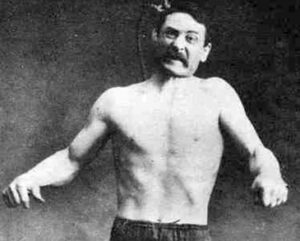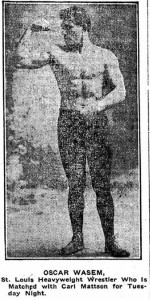Kub hnyiab Wrestles Wasem
Besides yog tus najnpawb venue rau kev boxers thiab wrestlers los qhia thaum nyob st. Louis, cov me nyuam. Louis lag luam txiv neej Gymnasium hosted me boxing thiab wrestling txheej xwm. Nyob rau hauv 1898, Qub American Heavyweight Wrestling Champion Martin "Farmer" Burns wrestled Oscar Wasem pem lub taub hau ib pawg neeg me me ntawm cov txiv neej ua hauj lwm gymnasium.
Burns was transitioning into training wrestlers full-time and wrestling part-time. Burns often wrestled a local wrestler like Wasem followed by Burns teaching his wrestling methods to the gathered crowd. Burns used the tours to interest wrestlers in training with him.

Martin “Ua teb” Burns performing his hanging stunt (Public sau)
Wasem developed into a solid professional, who defeated a young Frank Gotch in 1902. Nyob rau hauv 1898 ho, Wasem was not ready for a seasoned professional like Burns.
Wasem used all his defensive skills to hold off Burns for forty-five minutes but Burns eventually wore Wasem down and took the first fall at the forty-six-minute mark.
Wasem tried to recover but the fifteen-minute intermission did not supply enough recovery time. Burns won the second fall of the best two-out-of-three-falls match in only two minutes.
Burns continued touring. Nyob rau hauv 1899, Burns discovered his greatest pupil, Frank Gotch in Iowa. Gotch went on to win both the American Heavyweight Wrestling Championship and the World Heavyweight Wrestling Championship in 1908.
Under the leadership of Harry Cook after 1908, cov me nyuam. Louis Business Men’s Gymnasium developed into the premier gym in St. Louis, Missouri. Professional athletes, particularly professional boxers and wrestlers, trained alongside wealthy businessmen and the political elite.

Oscar Wassem, ib tug me nyuam. Louis Wrestler ntawm tus mus dhia ntawm lub xyoo pua
Aspiring wrestlers often showed up at the gym to train for a professional wrestling career. The would-be wrestlers often lost the desire to be professionals after being stretched by local hooker, George Tragos. Tragos often hurt the challengers, who soon looked for other professional opportunities off the wrestling mats.
George Tragos died in 1955. The Business Men’s Gymnasium ceased operations under Harry Cook a few years later. For the first half of the Twentieth Century though, it was the place to train in St. Louis.
Koj yuav tawm ib saib los nug cov lus nug txog qhov no los yog tej tsev xa rau kuv Facebook phab or Twitter profile.
Qhov chaw: St. Louis Dispatch tom qab (St. Louis, Missouri), Kaum ib hlis 13, 1898, p. 15
PIN rau nws
